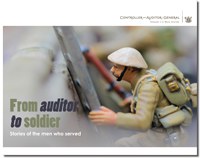Albert Andrew Cairns
 Albert Andrew Cairns was from Petone. Born in 1885, he was the youngest of eight children – his family called him “Tot”. Albert joined the Audit Department in December 1903.
Albert Andrew Cairns was from Petone. Born in 1885, he was the youngest of eight children – his family called him “Tot”. Albert joined the Audit Department in December 1903.
By the outbreak of WW1, Albert had attained the position of Audit Examiner, Grade VII. He was 28 years old when he joined the New Zealand Expeditionary Force in February 1915. By then, local newspapers report that Albert had been a member, secretary, and often auditor of the Petone Junior Rugby Club, Petone Cricket Club, Petone Catholic Club, and Petone Athletics Club.
Albert was sent to Egypt with the New Zealand Field Artillery, 4th Battery on 17 April 1915. From there, he was sent to Gallipoli. As part of the 4th Artillery Battery, Albert would have been involved in the August 1915 offensive on enemy positions.
New Zealand artillery batteries provided support for the 1st Brigade of Australians in their successful attack at Lone Pine.
The Allied forces were eventually forced to retreat from Gallipoli later in 1915. Albert was then sent to France and promoted to the rank of Corporal in December 1915. He served on the Western Front and was injured in a training exercise in France on 26 June 1916, when he twisted his knee. He was treated at a New Zealand Expeditionary Force hospital in France, where the injury was classed as “trivial.”
However, Albert continued to be in pain and was sent to the United Kingdom for treatment. He was treated at Meath Hospital in Dublin, where his injury was diagnosed as “synovitis” in the right knee
Synovitis is a painful inflammation in the joints. At that time, the main treatment for synovitis was prolonged rest. Albert was treated at several hospitals in the United Kingdom, including Hornchurch Convalescent Hospital and the New Zealand First General Hospital Brockenhurst. He was also granted a period of leave in May 1917.
After recovering from his injury, Albert was sent to the Artillery Reserve Depot at Aldershot, England, in September 1917. From there, he was posted to the New Zealand Field Artillery in France on 21 December 1917.
In August 1918, he was sent to an artillery school, rejoining his unit a month later. After a further period of leave, Albert was posted back to New Zealand in January 1919 and discharged from the New Zealand Expeditionary Force on 28 March 1919.
Albert was awarded the 1914-15 Star, the Victory Medal, and the British War Medal.
He rejoined the Audit Department as an Audit Examiner, Class VI, but left several years later.
Albert died in Wellington on 5 November 1944. He is buried in the soldiers’ section of Karori Cemetery.

